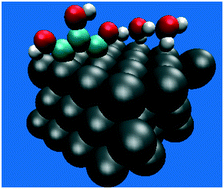Insights into the roles of water on the aqueous phase reforming of glycerol†
Abstract
Aqueous phase reforming (APR) of sugar alcohol molecules derived from biomass, e.g., CxH(2x+2)Ox (aq) + xH2O → xCO2 (g) + (2x + 1)H2 (g), creates hydrogen gas sustainably, making it an important component of future bio-refineries; however, problems with the cost, activity, and selectivity of present precious metal based catalysts impede its broader adoption. Ideally, new catalysts would be designed to optimize activity and selectivity; however, a comprehensive understanding of the APR mechanism is lacking. This is complicated by the fact that the primary biomass-derived sugar alcohols are large molecules (meaning that their reaction networks are large) and because of the presence of liquid water. Water influences catalytic phenomena in multiple ways, including altering the thermodynamics of catalytic surface species and participating in catalytic reactions. Understanding the mechanism of APR requires understanding these various effects; however, computational strategies based solely on density functional theory (DFT) are computationally prohibitive for such large and complicated reaction networks. In this work, we investigate the mechanism of APR reactions in the context of glycerol reforming. To calculate the reaction network, we combine DFT calculations, force-field molecular dynamics (MD) simulations, linear scaling relations (LSRs), transition state scaling (TSS) relationships, and data from the literature into a microkinetic model. The microkinetic model is run under vacuum and aqueous phases in order to learn about the roles of water molecules on the mechanism of glycerol APR. We identify four such roles: providing surface hydroxyl groups, which promote oxidation of surface CO formed in glycerol decomposition; promoting C–H scissions; promoting O–H scissions; and inhibiting the thermodynamics of decarbonylation of C3 intermediates.

- This article is part of the themed collection: Reaction Chemistry & Engineering Emerging Investigators


 Please wait while we load your content...
Please wait while we load your content...